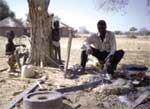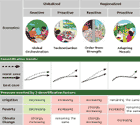Desertificación
Únicamente la versión en inglés ha sido aprobada por el Comité Científico de GreenFacts
Información sobre nuestra estructura de 3 niveles
5. How will different future development paths influence desertification?
- 5.1 Which scenarios have been explored in this assessment?
- 5.2 Are pressures on drylands expected to increase?
- 5.3 What are the key challenges for the future?
The source document for this study states:
"Population growth and increase in food demand will drive expansion and intensification of cultivated lands. If unchecked, desertification and degradation of ecosystem services in drylands will threaten future improvements in human well-being and possibly reverse gains in some regions."
Source & ©: MA ![]() Desertification Synthesis Report (2005),
Desertification Synthesis Report (2005),
Chapter 4, p.11
5.1 Which scenarios have been explored in this assessment?
The source document for this study states:
"Scenarios Approach
A better understanding of development options and management paradigms for the future can be achieved through scenario development.To make sound choices, we need to understand the consequences of alternative actions or inactions. This is facilitated by creating scenarios that are plausible and that tell stories about how the future might unfold, in both words and numbers. The MA scenarios were developed using established, peer-reviewed global models for quantitative projections (such as land use change, carbon emissions, water withdrawals, and food production) and qualitative analysis. The quantitative models did not address thresholds, risk of extreme events, or impacts of large or irreversible changes in ecosystem services. Scenarios are not forecasts, projections, or predictions. They are intended to provoke questions, widen perspectives, illuminate key issues, and therefore support better-informed and rational decision-making. In so doing, they attempt to reduce uncertainty about future outcomes of management approaches (S6, S2).
The MA generated four scenarios that explore how combinations of policies and practices may affect changes in ecosystem services, human well-being, and desertification (See Box 4.1. ![]() ). The scenarios were developed with a focus on the likely conditions in 2050, although they include some information through the end of the century. They specifically address desertification and human well-being in drylands. These four scenarios were not designed to explore the entire range of possible futures; other scenarios could be developed with either more optimistic or more pessimistic outcomes
). The scenarios were developed with a focus on the likely conditions in 2050, although they include some information through the end of the century. They specifically address desertification and human well-being in drylands. These four scenarios were not designed to explore the entire range of possible futures; other scenarios could be developed with either more optimistic or more pessimistic outcomes
(S8 ![]() Figure 8.5, S9
Figure 8.5, S9 ![]() )."
)."
Source & ©: MA ![]() Desertification Synthesis Report (2005),
Desertification Synthesis Report (2005),
Chapter 4, p.11-12
5.2 Are pressures on drylands expected to increase?
The source document for this study states:
"Key Findings from the MA Scenarios
In all four scenarios, desertified area is likely to increase, though at different rates. Poverty and unsustainable land use practices continue to be the main factors driving desertification in the near future. The relief of pressures on drylands is strongly correlated with poverty reduction. Under all four MA scenarios, population growth and increase in food demand will drive an expansion of cultivated land, often at the expense of woodlands and rangelands. This is likely to increase the spatial extent of desertified land. No scenario indicates a reversal in the threat of desertification (S9 ![]() , S8
, S8 ![]() Figure 8.5). (See Figure 4.1.
Figure 8.5). (See Figure 4.1. ![]() )
)
In all the scenarios, climate change is linked to desertification, and the impacts of climate change vary according to region and the management approach adopted. Climate change is expected to affect the global hydrological cycle and local precipitation trends. The local manifestation of these global climate changes is strongly location-dependent. It is likely that extreme events will further intensify, bringing more floods and more droughts (S8 ![]() Figure 8.5, S14
Figure 8.5, S14 ![]() .4.4).
.4.4).
Coping with desertification and related economic conditions in drylands will likely fare better in a future where proactive management approaches are used. In a proactive approach, ecosystem management is aiming to be adaptive to changes and to make ecosystems more resilient, which is seen as also reducing the vulnerability of society to the disturbances caused by desertification. As a result, measures such as adaptations to climate change and non-expanding irrigation can jointly lead to decelerated desertification rates. This approach might take some time to show its benefits, however, as the necessary changes in development and learning capacities first need to be further developed and improved. In contrast, under a reactive management regime, current pressures (climate change, overgrazing, and large-scale irrigation) on ecosystem services are likely to stay the same or intensify, leading to further desertification. The regionalized-reactive scenario demonstrates the greatest unsustainability of dryland development (S.SDM).
Globalization will not necessarily lead to increased desertification. Prospects for cooperation and resource transfers to support ecosystem management are better in this case due to the institutional reforms and the fast rate of technological development. In the globally proactive management scenario, policy reforms such as strengthening of property rights (either private or collective) as well as better integration of environmental issues lead to relatively less pressure in drylands. Market and policy failures can still pose risks of desertification, however. In contrast, in a fragmented world, the role of a global agreement is more limited either because of the diminished interest in resource transfers or because of the lack of interest beyond the national or regional boundaries (S14 ![]() .ES, S14
.ES, S14 ![]() .4.3)."
.4.3)."
Source & ©: MA ![]() Desertification Synthesis Report (2005),
Desertification Synthesis Report (2005),
Chapter 4, p.12-13
5.3 What are the key challenges for the future?

A farmer in semi-arid Burkina Faso works as a blacksmith during the dry season
Source: MA
The source document for this study states:
"Key Challenges for the Future
Persistent, substantial reduction in the provision of ecosystem services as a result of water scarcity, intensive use of services, and climate change is a much greater threat in drylands than in non-dryland systems. The greatest vulnerability is ascribed to sub-Saharan and Central Asian drylands. For example, in three key regions of Africa—the Sahel, Horn of Africa, and Southeast Africa—severe droughts occur on average once every 30 years. These triple the number of people exposed to severe water scarcity at least once in every generation, leading to major food and health crises. Unconditional, free supply of food or water to the vulnerable dryland people can have the unintended effect of increasing the risk of even larger breakdowns of ecosystem services. Local adaptation and conservation practices can mitigate some losses of dryland services, although it will be difficult to reverse the loss of food and water provision services and the supporting biodiversity (S.SDM, C20.6, C7 ![]() .3.4).
.3.4).
The projected intensification of freshwater scarcity will cause greater stresses in drylands. If left unmitigated, these stresses will further exacerbate desertification. Water scarcity affects approximately 1–2 billion people today, most of them in drylands. This leads to overexploitation of surface and ground-water resources and eventually magnifies problems related to desertification.Freshwater availability in drylands is projected to be further reduced from the current overall average of 1,300 cubic meters per person per year. While this average figure masks great variations, it is already well below the lowest threshold of 2,000 cubic meters required for human well-being and sustainable development (C7 ![]() .ES, C24
.ES, C24 ![]() .ES, C22
.ES, C22 ![]() .ES).
.ES).
The prospects for implementing the UNCCD differ significantly under the four MA scenarios. Implementation will be the most difficult in a regionalized-reactive world, while prospects improve in a more globalized world and with proactive ecosystem management. The four MA scenarios give an indication of how effectively the UNCCD directives can be implemented by the affected countries when operating under broadly different management approaches. In a regionalized world with only reactive environmental management, the scope for global environmental agreements is rather poor. In this reactive management mode, desertification will likely increase further before its impacts—massive famines and environmental and hunger refugees—trigger a significant response. A globalized world provides a more favorable situation for implementation of the UNCCD at the global scale through facilitation in the flow of resources and technologies, but here too it will depend which kind of overall management approaches are favored (S14 ![]() .4.3)."
.4.3)."
Source & ©: MA ![]() Desertification Synthesis Report (2005),
Desertification Synthesis Report (2005),
Chapter 4, p.13



